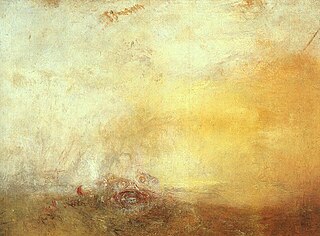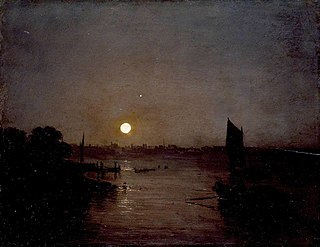
Joseph Mallord William Turner, known in his time as William Turner, was an English Romantic painter, printmaker and watercolourist. He is known for his expressive colouring, imaginative landscapes and turbulent, often violent marine paintings. He left behind more than 550 oil paintings, 2,000 watercolours, and 30,000 works on paper. He was championed by the leading English art critic John Ruskin from 1840, and is today regarded as having elevated landscape painting to an eminence rivalling history painting.

Chichester Canal is a painting by the English Romantic landscape painter, watercolourist and printmaker J. M. W. Turner. It was painted in 1828 and was commissioned by George Wyndham, 3rd Earl of Egremont. It is now in the Tate Collection.

The Burning of the Houses of Lords and Commons, 16th October, 1834 is the title of two oil on canvas paintings by J. M. W. Turner, depicting different views of the fire that broke out at the Houses of Parliament on the evening of 16 October 1834. They are now in the Philadelphia Museum of Art and Cleveland Museum of Art.

Snow Storm: Hannibal and his Army Crossing the Alps is an oil on canvas painting by J. M. W. Turner, first exhibited in 1812. Left to the nation in the Turner Bequest, it was acquired by the National Gallery in London in 1856, and is now held by the Tate Gallery.

Sunrise with Sea Monsters is an unfinished oil painting by English artist J. M. W. Turner.

Snow Storm, or Snow Storm: Steam-Boat off a Harbour's Mouth, is a painting by English artist Joseph Mallord William Turner (1775–1851) from 1842.

Port Ruysdael is an 1826 oil on canvas painting by the English painter J. M. W. Turner. It is in the collection of the Yale Center for British Art in New Haven.
Martin Richard Fletcher Butlin, CBE, FBA is a British art historian. His main field of study is British art history and his published works reflect, in particular, a study of art of the 18th and 19th centuries. He is an authority on J.M.W. Turner (1775–1851) and William Blake (1757–1827).

Dolbadarn Castle is an oil painting by J. M. W. Turner (1775–1851) depicting Dolbadarn Castle, created in 1798–1799. It is part of a body of work completed by Turner during a tour of the region, which included Dolbadarn, Llanberis and other parts of Snowdonia. Many supporting studies can be found in a sketch book now held by Tate Britain. When Turner returned to his London studio he developed these sketches into a number of more accomplished paintings of North Wales, including this one, which is now kept at the National Library of Wales.

Whalers is an 1845 painting by British artist J. M. W. Turner. Done in oil on canvas, the work depicts a whaling ship and her launches pursuing a whale. Originally created with the hope that collector Elhanan Bicknell would purchase it, the work is currently found in the collection of the Metropolitan Museum of Art.

Norham Castle, Sunrise is an oil-on-canvas painting by English painter J. M. W. Turner, created around 1845. The painting depicts Norham Castle, overlooking the River Tweed, the border between England and Scotland. The painting was bequeathed to the National Gallery of British Art as part of the Turner Bequest in 1856. It remains in the collection to this day. It was one of the artist's last paintings, and falls within his "Modernist" period. This piece is well known for Turner's attentiveness to dawn light, and the softened silhouette it brings.

The Golden Bough is a painting from 1834 by the English painter J. M. W. Turner. It depicts the episode of the golden bough from the Aeneid by Virgil. It is in the collection of the Tate galleries.

Landscape with Windmill and Rainbow is a painting attributed to J. M. W. Turner, painted c. 1795–1800. It has the dimensions of 70.5 by 90.2 cm. It is believed to have been created at least partially in a painting by Thomas Gainsborough. It is held at the Tate Gallery, in London.

Interior of a Romanesque Church is an oil on mahoganey painting by J. M. W. Turner, painted c. 1795–1800. It depicts the interior of a Medieval church in the romanesque style. It is held at the Tate Gallery, in London.

Moonlight, a Study at Millbank is an oil painting by J. M. W. Turner, painted c. 1797. The nocturne is painted in oils on a mahogany board which measures 31.4 cm × 40.3 cm. It has been held by the Tate Gallery since 1910.

Caernarvon Castle is a painting by J. M. W. Turner, painted c. 1798.

Morning amongst the Coniston Fells, Cumberland, is a painting by J. M. W. Turner, painted c. 1798. It depicts the Old Man of Coniston, Cumbria, England.

Tate Britain holds a self-portrait of J. M. W. Turner which it dates to c.1798 or c.1799, when the artist was aged about 23 or 24 years old.

Peace – Burial at Sea is a painting in oils on canvas by the English Romantic artist J. M. W. Turner (1775–1851), first exhibited in 1842. The work is a memorial tribute to Turner's contemporary the Scottish painter Sir David Wilkie (1786–1841). The canvas depicts Wilkie's burial at sea. This work was intended as a companion piece to War. The Exile and the Rock Limpet which alludes to the sordid demise of the former Emperor of France Napoleon Bonaparte. The two works are characterized by sharply contrasting colors and tones: War utilizes a strident yellow and red while Peace is painted a cool blend of white, blue and black.

The Shipwreck is a landscape painting by J. M. W. Turner in the collection of the Tate. It was completed around 1805, when it was exhibited in Turner's own gallery. The painting is an important example of the sublime in British art.


















